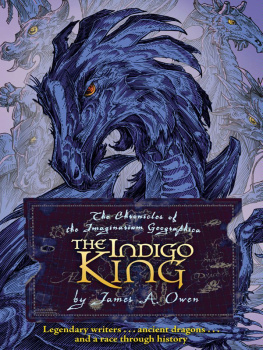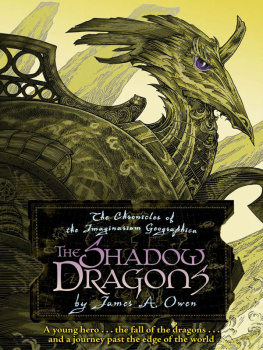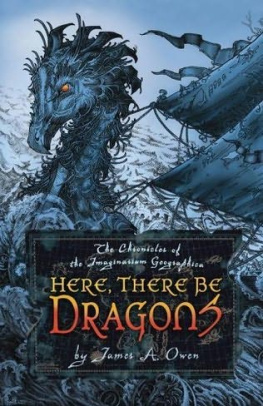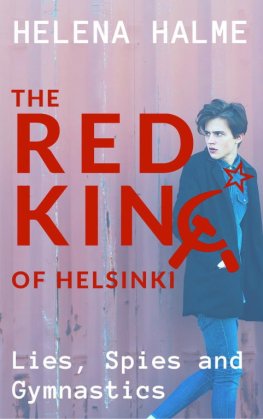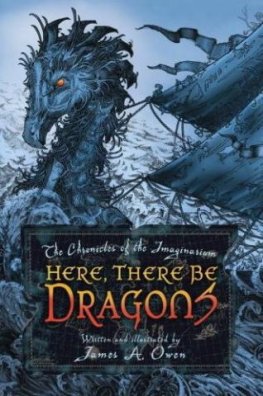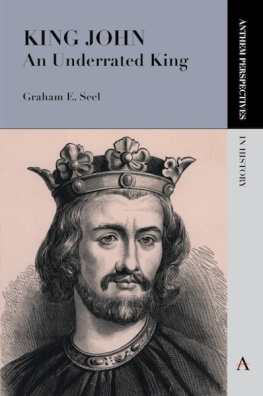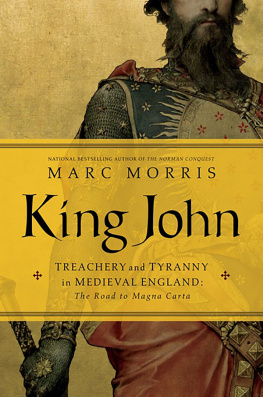THE CHRONICLES OF THE IMAGINARIUM EOGRAPHICA
THE INDIGO KING
Written and illustrated by
James A. Owen

For Sophie
SIMON & SCHUSTER BOOKS FOR YOUNG READERS
An imprint of Simon & Schuster Childrens Publishing Division
1230 Avenue of the Americas, New York, New York 10020
www.SimonandSchuster.com
This book is a work of fiction. Any references to historical events,
real people, or real locales are used fictitiously. Other names,
characters, places, and incidents are products of the authors
imagination, and any resemblance to actual events or locales or
persons, living or dead, is entirely coincidental.
Copyright 2008 by James A. Owen
All rights reserved, including the right of reproduction in whole or
in part in any form.
SIMON & SCHUSTER BOOKS FOR YOUNG READERS is a
trademark of Simon & Schuster, Inc.
Book design by Christopher Grassi and James A. Owen
The text for this book is set in Adobe Jenson Pro.
Manufactured in the United States of America
2 4 6 8 10 9 7 5 3 1
Library of Congress Cataloging-in-Publication Data Owen, James A.
The indigo king / written and illustrated by James A. Owen.
p. cm.(The Chronicles of the Imaginarium Geographica ; bk. 3)
Summary: When, in 1931, there is a breach between this world and the Archipelago of Dreams,
John and Jack, two of the Caretakers of the Imaginarium Geographica, must race through history using a time travel device left by Jules Verne, and discover the identity of the Cartographer.
ISBN-13: 978-1-4169-5107-0 (hardcover)
ISBN-10: 1-4169-5107-5 (hardcover)
eISBN-13: 978-1-4169-9918-8
[1. Time travelFiction. 2. Fantasy.] I. Title.
PZ7.O97124Ind 2008
[Fic]dc22
2008004966

Contents



The Indigo King was the book that I most looked forward to writing, the book I dreaded writing, the book that was the hardest to write, and my favorite book so far. And it would not be the book that it is without the hard work and dedication of my editors.
David Gale is exceptionally patient and knows how to persuade rather than push a writer. He gave me support when I needed it, and room when I needed that. Navah Wolfe, whom I got to know as an online friend prior to her employment at Simon & Schuster, is an excellent editorial assistant for David and is as first-class as they come where this author is concerned. She is smart, and caring, and she kept me on my game. Dorothy Gribbin remains an editorial rock in my world. Ive often rethought certain passages just because I knew shed question them. And its always been for the better. And Valerie Shea is a rock star. I sometimes feel like shes been more exacting with details than I am, and that fact both impresses and humbles me.
My legal team added a new name, Erik Hyman, who is both deft and witty, and as reliable as his Loeb & Loeb compatriot Craig Emanuel. Both have been invaluable supporters of my work, as have my managers at the Gotham Group: Julie, Ellen, and Lindsay. Ben Smith at ICM remains the agents agent, and I am grateful to them all.
My senior apprentice, Mary McCray, stepped to the forefront of the work on this book by turning all of my thumbnail sketches into full-size layouts. Lon Saline, apprentice emeritus, added his skilled touch to several pages, and Jeremy Owen kept all of the trains running on time at the Coppervale Studio while also doing a smashing coloring job on the cover.
Joe Pruett of Desperado Publishing helped me to jump-start a few projects that have languished for far too long and in the process gave us another vehicle for promoting the novels.
Justin Chanda, publisher of Simon & Schuster Books for Young Readers, opened a door into our mutual futureand I am lucky to have him on my side. Also on that front, my publicists Kate Smyth and Paul Crichton have done a stunningly good job of promoting me and my work, organizing my tours, troubleshooting, and in general just taking good care of this author. And my art directors, Lizzy Bromley, Chle Foglia, and Laurent Linn, continue to make the books look better than Id dreamed.
Joe LeFavi brought me together with Jason Lust, Lisa Henson, and Brian Henson, all of whom have become my friends and among the biggest supporters of my ambitions.
Stephenson Crossley deserved to be acknowledged in the first two books, as none of them would exist if he hadnt fed, housed, and encouraged me while I was trying to sell the first bookbut his girlfriend, Karen, said if I didnt wait until at least the third book, hed be impossible to live with.
And not least among my influences, I want to thank Jimmy Swihart, my first business partner, who has recently come back into my life and brought with him some great memories.
The greatest of my influences, however, is my wife, Cindy. Without her, I would not have lived the life I have, had the family were raising, and created the work that I love. And I am forever thankful for her love and support.

In the centuries that would pass, the spacious stone room known as Solitude would fill with an accumulation of culture; not by design, but because those who would eventually come to seek the occupants skills would feel the obligation to bring something, anything, as gifts, or perhaps tribute. But that was in a time yet to come. In the present moment, it was empty save for the items hed brought with him: a torn robe, an empty scabbard, a quill and half-filled bottle of ink, and as many rolls of parchment as he could carry.
When he entered, the door had swung shut behind him. He knew without touching it that it had locked, and also, with less assurance, that it would probably not be opened again for many years.
He had once had a nameseveral names, in factall of which were irrelevant now. In his youth he had aspired to be a great man, and had been afforded many opportunities to fulfill that destiny; but far too late, he learned that it was perhaps better to be a good man, who nevertheless aspires to do great things. The distinction had never mattered to him much before.
Solitude had not been created for him, but he took possession of it with the reluctant ease of an heir who receives an unexpected and unwanted inheritance. He laid the robe in one corner, and the scabbard in another, then sat cross-legged in the center of Solitude to examine the rolls of parchment.
Some of them contained drawings and notations; a few, directions that may or may not have been accurate, to places that may or may not have existed. They were maps, more or less, and at one time it had been his driven purpose to create them. But that was before, when his sight was clearer and his motives more pure. Somehow, somewhen, he had lost his wayand in the process, ended up on a path that had brought him here, to Solitude.
Still, he could not help but wonder: Was it the first step on that path, or the last, that had proven to be his undoing? He looked down at the maps. The oldest had been made by his hand more than a millennium before; but the newest of them had been begun, then abandoned, a century ago. He examined it more closely and saw that the delicate lines were obscured by bloodthe same that marked the cloak and scabbard as symbols of his shame.
Next page
